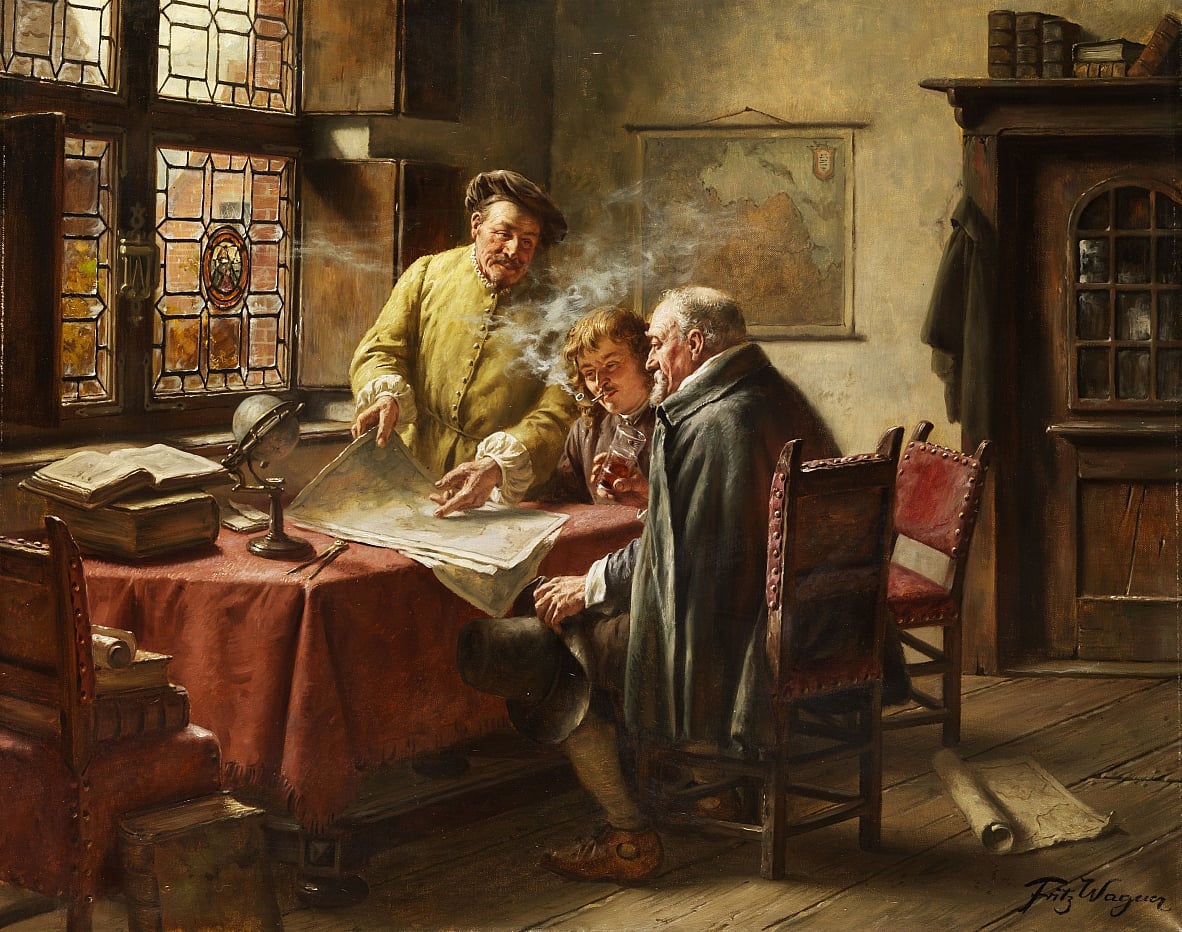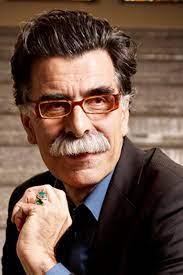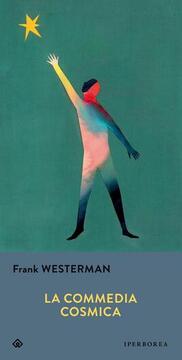Dutch literature in Italy
The Renaissance of Dutch literature
The reception of Dutch literature in Italy has always experienced highs and lows throughout the centuries. Although literary works from the Netherlands and Flanders faced resistance in certain periods, in the last 20 years, Italian readers have demonstrated a growing openness and interest in the countries’ rich literary tradition.
De beelden van de Lage Landen – Images of the Low Countries

Holländische Handelsherren - Fritz Wagner
An early impact of Dutch literature in Italy dates back to the Renaissance, when humanism and cultural exchanges facilitated the dissemination of Dutch literary works. Over the subsequent centuries, however, linguistic and cultural barriers, coupled with political and economic factors, limited the diffusion and acceptance of such works in Italy. The first significant contacts between Italy and the Low Countries in recent history, in fact, took place in the era of the Renaissance, when wealthy merchants and bankers travelled between Northern and Southern Europe. It was the merchants and writers of the time, such as Lodovico Guiccardini, who provided Italy with an initial image of the Low Countries. The picture that emerged was that of a beautiful, clean, and dynamic country, much like the wealthy merchants who had flourishing trade relations with Italy and the rest of the world. The image of a free, proud, modest, sober, and tolerant people also appears in the letters of Florentine nobleman Marcello Sacchetti.

''Olanda'' by Edmondo De Amicis
Towards the end of the 19th century, Edmondo De Amicis once again shaped Italy's image of the Netherlands with his travel diary "Olanda" (Holland), in which he praises the Dutch as ingenious and frugal people, modest and rational, also commending the dynamism and entrepreneurship of Dutch cities. The image Italy has always had of the Netherlands – a prosperous and tolerant country where freedom and rights are paramount – has a very long history that has been confirmed over the centuries. A change occurred recently, during the Covid-19 pandemic, when Italy and the rest of the European Union reconsidered their view of Dutch progressivism due to the Netherlands’ rejection of Eurobonds.
New Trends in the Reception of Dutch Literature in Italy
While only a few Italians knew some Dutch authors and often mispronounced their names until a few decades ago, recent studies have shown that the reception of Dutch literature has experienced a true renaissance in Italy over the past twenty years. This is attributed to an unprecedented increase in translations of Dutch authors into Italian. Additionally, the 2010s saw the start of a trend towards rediscovering the classics of Dutch literature: many works of the 19th and 20th centuries have been retranslated, or rediscovered and translated for the first time. To name just a few, ‘’De donkere kamer van Damokles’’ (The Darkroom of Damocles) by W.F. Hermans translated by the publishing house Iperborea and "Een Illusie" (An illusion) by Louis Couperus is currently being translated and will be published by the same publishing house.




Notably, in 2020, Lotte Jensen, a professor of Dutch literature and cultural history at the University of Nijmegen, published an article titled "De renaissance van de Nederlandse literatuur begint in Italie" (Jensen 2020). Today, names like Cees Nooteboom and Kader Abdolah have also established themselves in the Italian literary landscape. The reasons for the success of Dutch literature in Italy can be found in the cultural promotion policies of the Nederlands Letterenfonds. In recent years, Italy has become one of the main countries where the Nederlands Letterenfonds has concentrated its investments. Besides the German market, which has always been the primary market for Dutch translations for historical and cultural reasons, and except for the English-speaking market, which is the dominant market in the publishing industry, Italian has become the primary language in which the Nederlands Letterenfonds has invested between 2021 and 2022. Although Italy has become one of the main targets of the Nederlands Letterenfonds over time, it is important to emphasize that Dutch titles reach Italy only after achieving success in English or German-speaking countries. Positive reviews from other countries seem to further encourage the discovery of new Dutch works in Italy.
The Triple Role of Translators
While the cultural investment policies of the Nederlands Letterenfonds undoubtedly played a leading role in the dissemination of Dutch literature in Italy, it is crucial to recognize the fundamental contribution of translators, who usually play a triple role. They not only translate works assigned to them by publishers, but are often the first advisors that publishers turn to when evaluating the quality of new titles. Additionally, translators, as experts in both the source and target cultures, regularly act as cultural mediators as well, advising publishers on which authors and titles might succeed in the Italian market.
Translator Claudia Di Palermo, for example, believes that Italy in particular needs a clearer historical and socio-cultural context to better frame Dutch authors. Mutual knowledge between the two countries is oftentimes based on stereotypes, which is why Di Palermo argues that she must not only translate a novel, but also provide Italian readers with the tools to frame, understand and interpret it.
Iperborea
A significant contribution to the reception of Dutch literature in Italy has historically been provided by the publishing house Iperborea, founded in 1987 in Milan by Emilia Lodigiani. Since 1991, the year of publication of "Een lied van schijn en wezen" (Il canto dell'essere e dell'apparire) by Cees Nooteboom, Iperborea has consistently facilitated contact of Dutch authors with the Italian audience. From 2000 to 2020, the number of Dutch authors published in Italy has grown exponentially, especially in the second decade. As of today, there are 95 titles translated from Dutch, of which 87 have already been published, and 8 are in the process of publication. Interviews conducted by Gentile (2022) with a group of translators collaborating with Iperborea have revealed that the publishing house has always pursued a consistent editorial policy for all authors in its catalogue, making the Milanese publisher a guarantee of quality for Dutch authors.

New Literary Genres – From Classics to Literary Essays

Among the most successful works published in Italy are those of Cees Nooteboom, Kader Abdolah, and Harry Mulisch. However, as mentioned before, a lot of classics of Dutch literature are being rediscovered. Iperborea has played a major part in the trend, because the publishing house not only aims at promoting contemporary literature, but also makes an effort to introduce the past of the country of origin's literature and, therefore, its history. In doing so, Iperborea seeks to address the lack of context pointed out by translator Claudia Di Palermo. Since 2000, Iperborea has launched a campaign to rediscover classic works, such as "Max Havelaar" (Multatuli), "Storie di Amsterdam" (Nescio), "L'amico perduto" (Hella Haasse), "Le sere" (Gerard Reve), and "La camera oscura di Damocle" (Willem Frederik Hermans).

Within this choir united by a common thread, the voice of writer and journalist Frank Westerman stands out. It’ safe to say that thanks to him, the Italian public has become familiar with a new literary genre, that of literary essays, of which Jan Brokken is also a representative. In the last two years, there has been an increase in translations of works belonging to this genre, halfway between fiction and reportage, thanks to the investments of the Nederlands Letterenfonds, so much so that translations of literary essays have even surpassed those of fiction works. Overall, what makes Dutch authors appealing and unique to the Italian public is their style and the themes they cover. The growing interest in universal themes present in Dutch literature, such as the quest for identity, engagement with history, and reflection on human complexity, has contributed to increase the appreciation of Dutch literary works in Italy.
In recent years, the reception of Dutch literature in Italy has experienced a true Renaissance, promoted, among other factors, by the cultural policies of the Nederlands Letterenfonds and the fundamental role of the publishing house Iperborea and translators, who also act as cultural mediators. In light of this trend, it can be assumed that the tendency will continue in the coming years, furthering the rediscovery of classics and the exploration of literary essays.
(Michele Restuccia)
References
Dagnino, Roberto, Prandoni, Marco, Cultura letteraria neerlandese. Autori, testi e contesti dal medioevo a oggi, Hoepli, Milano, 2020.
Gentile, Paola, De beelden van de Lage Landen in Italiaanse vertaling (2000-2020). Selectie, receptie en beeldvorming, EUT, Trieste, 2021.
Gentile, Paola, ‘’Il rinascimento della letteratura neerlandese in Italia e la (ri)scoperta dei classici. Nuove tendenze editoriali nella traduzione dal neerlandese in italiano’’ in: Rivista internazionale di tecnica della traduzione, EUT, Trieste, 2022.
Jensen, Lotte, De renaissance van de Nederlandse literatuur begint in Italië, link: https://www.volkskrant.nl/columns-opinie/de-renaissance-van-de-nederlandse-literatuur-begint-in-italie~bcfe38b7/, 3 november 2020 [last viewed: 18/01/2024].
Nederlands Letterenfonds Database, https://nlf.my.salesforce-sites.com/vertalingendatabase/.
Restuccia, Michele, Do Italy and the Netherlands know each other well enough?, link: https://dlit.univie.ac.at/dlit/italy/dlitit-claudia-di-palermo/ [last viewed: 18/01/2024].
